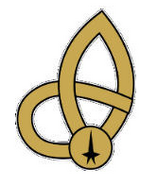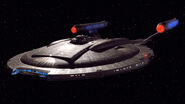Starfleet is the deep-space exploratory and defense service maintained by the United Federation of Planets. Its principal functions include the advancement of Federation knowledge about the galaxy and its inhabitants, the advancement of Federation science and technology, the defense of the Federation, and the facilitation of Federation diplomacy.
As per its mandate of deep-space exploration, its personnel are frequently brought into contact with cultures and sentient species whose existences were unknown to the Federation. Starfleet officers therefore acted as official representatives of the Federation in these cases. Starfleet vessels were also frequently used to ferry ambassadors on diplomatic missions.
History[]
The Federation's Starfleet arose mostly out of the United Earth Starfleet, which in 2161, was merged with the Alpha Centauri Space Research Council, Andorian Guard, Vulcan Space Council, and Tellar Space Administration, each with their own respective areas of expertise. Each portion of Starfleet had its own emblem, reflecting the major division to which personnel or starships were assigned. Coming from the Earth Starfleet, each functional area of Starfleet had its own departmental color to allow easy visual distinction between departments for crewmembers. Earth had used gold for command, red for ship operations, and blue for sciences. With the MACO organization joining Starfleet as the Starfleet Marines and Starfleet Security, a dark gray was added as a fourth uniform color.
The Earth Starfleet folded its personnel into the new united agency, with its 323,792 active duty personnel and 108,515 reserve duty personnel (combined between UE Starfleet, MACO, and several other subsidiary organizations that were subsequently combined into the new fleet), the Vulcans with 98,455 personnel, Tellarites with 25,890, Alpha Centaurians with 86,733, and Andorians with 114,967 personnel made up the new fleet's strength of 649,837 active duty personnel.
Early on, most ships were segregated, with the Vulcans refusing to serve in Starfleet for nearly a century till Spock joined in the 2250s. The impression given to other planets, notably the Klingons after a disastrous first contact in 2223, was that the United Federation of Planets was a 'homo sapiens only club.' Despite this impression, a number of other species would join Starfleet and explore the stars as part of the joint service.
The 22nd century was a period of growth for the combined service, and the various species began working together more often and with better interspecies cohesion. Andorians, Alpha Centaurians, Aktevans, Nasheyans, Naroyans, Saurians, Denobulans, and Caitians worked together more often and would go on to command vessels and even advance to the admiralty of the service. By 2196, Starfleet had retired the venerable Daedelus-class vessels,
The 23rd century was an era of expansion and conflict. New ship designs expanded the customary saucer section, with variants such as the Loknar, Anton, Constitution, and several others during the first fifty years. The most disastrous conflict began with first contact with the Klingons in 2224, causing nearly 70 years of hostility with that power. Uniforms during this time became simplified, with duty uniforms now consisting of a black undershirt, duty overshirt, black pants, and boots. An alternative uniform for ladies was a skirt option at this time.
With a series of advances in research and development, began the Constitution Phase II project, resulting in one full upgrade as a testbed, and the USS Enterprise was to be part of this project. However, Lt Cdr Scott, along with several colleagues at Starfleet, found the Leeding engines systems even more efficient, and the Enterprise was upgraded with several experimental systems, leading it to be called the 'Enterprise class,' which is more a sub-class of the Constitution class ship. Dozens of ships were upgraded, and since its proven track record, the Anton-class was upgraded into the Miranda-class (its first upgrade being the USS Miranda), Loknar, and several other vessels as part of a fleet-wide modernization effort.
The USS Excelsior was an attempt to create a reliable transwarp starship, which was an unsuccessful drive system, but the space frame proved reliable, leading to production of the ship. Soon after, a sub-class was developed, with the Enterprise-B (2294), along with 55 other ships, being produced, with improved impulse engines, sensors, and shuttle operations over regular Excelsior-class ships. Later developments in technology were incorporated back into the Excelsior, with the Ambassador class replacing it as the leading class vessel in the 2320s and 2330s. After the Khitomer incident, Starfleet developed several new classes, notably the Galaxy and Nebula, leading to a new era of peace and exploration.
With the Borg incident in 2366, Starfleet pushed a more intense modernization effort, leading to the Sovereign, Norway, Akira, Steamrunner, and Defiant classes, along with an uprated Galaxy class (adding twin phaser strips to the warp engines, along with overall system upgrades).
Early Starfleet Divisions[]
- Exploration (United Earth Space Probe Agency, UESPA)
- Operations, Supply (Tellar Space Administration)
- Research/Exploration (Alpha Centauri Space Research Council)
- Defense (Andorian Guard)
- R&D, Administration (Vulcan Space Council)
Early Starfleet Insignia[]
Early Starfleet Uniform Colors[]

Early Starfleet Uniform Colors
Early Starfleet Interstellar Admissions[]
- 2161: Earth, Vulcan, Tellar, Alpha Centauri
- 2163: Akteva III, Denobula, Cait (15 Lyncis)
- 2164: K'Tharix, Saurians, Betelgeusians
- 2166: Monchezke
- 2169: various Earth colonies
- 2173: Nasheya, Ottoya, Naroya
- 2174: Arken II, Argos
- 2177: Arcturus, Efros Delta
- 2178: Betazed, Elaysia
- 2181: Rhaandaran,
Early Starfleet Ships[]
Starfleet inherited the United Earth Starfleet's ships, notably the NX-class, later named the Columbia class, the Dauntless class (the first combined service vessel, NCC-01), Intrepid Class, Daedelus class, and several others. Earth tended to keep ship classes in service for at least 20 years or more, with a propensity for modular components that made for easier upgrades when time came for servicing the starships.
Starfleet maintained in 2161:
- 20 NX-class ships; 10 of which were upgraded with a new engineering hull as 'Columbia class'
- Notable ships: NX-01 Enterprise, NX-02 Columbia (lost in space); Challenger (NX-03), Discovery (NX-04), Atlantis (NX-05), Endeavour (NX-06), Intrepid (NX-07), Defiant (NX-08), Avenger (NX-09)
- 14 Intrepid-class ships
- 24 Poseidon-class ships
- 120 Daedelus-class ships
- 32 Discovery-class ships
- 18 Ganges-class ships
Uniforms[]
Main Article: Starfleet Uniforms Current uniforms combine the aesthetic of the 2330 uniform, with the components of the 2274 uniform, which lasted several decades with minor variations.
Ranks[]
Enlisted / Non-Commissioned Officers[]
Enlisted ranks form the bulk of Starfleet's manpower, performing most duties on the ship, while commissioned officers usually form the bulk of department heads, ship commanders, and the command structure of Starfleet itself.
- E-1 (Crewman Recruit)
- E-2 (Crewman Apprentice)
- E-3 (Crewman)
- E-4 (Petty Officer Third Class)
- E-5 (Petty Officer Second Class)
- E-6 (Petty Officer First Class)
- E-7 (Chief Petty Officer)
- E-8 (Senior Chief Petty Officer)
- E-9 (Master Chief Petty Officer)
The rates E-1 to E-3 are the juniormost officers in Starfleet, wherein recruits go through Starfleet Basic Training, and then job training, then are placed in their duty posts. Depending on their functional areas, Crewmen can have different actual titles (Engineer's Recruit; Hospitalman Recruit; Airman Recruit; etc).
The rates E-4 to E-6 are non-commissioned officers, often referred to as Petty Officers in Starfleet. They perform not only the duties of their specific career field, but also serve as leaders to junior enlisted personnel. They must take responsibility for their subordinates, address grievances, inform the chain of command on matters pertaining to good order and discipline, and may even have to place personnel on report. The title Petty Officer comes from the French word petit, meaning something small. In medieval England, villages had several "petite" or "petty" officers who were subordinate to major officials. Thus, Petty Officers are assistants to senior officers.
Petty Officers have been an important part of the Starfleet since its beginning. Petty Officers served as Boatswains, Engineers, Gunners, Nurses, Repairmen, and various other rates. All NCO rates are worn on the left sleeve to this day, and the authority to wear gold rating badges and service stripes on the dress uniform and working coverall uniform is granted when a sailor completes and maintains twelve consecutive years of honorable service without any official record of bad conduct due to punitive action via non-judicial punishment or courts martial. The gold rating badges and service stripes are distinct from the Good Conduct Medal, which is awarded for three years of honorable service.
Coloration of the insignia for E-4 through E-9 depends upon the uniform worn. Black cloth with red or gold embroidered stripes is used on the coverall uniforms, while black embroidered stripes are used on the duty uniforms, and medium blue cloth with red or gold embroidered stripes is used on the working coverall.
Enlisted officers use stripes to indicate rank.
Master Chief Petty Officer[]
After attaining the rate of Master Chief Petty Officer, a service member may choose to further his or her career by becoming a Command Master Chief Petty Officer (CMDCM). A CMDCM is considered to be the senior-most enlisted service member within a command, and is the special assistant to the Commanding Officer in all matters pertaining to the health, welfare, job satisfaction, morale, utilization, advancement and training of the command's enlisted personnel. CMCs can be Command level (within a single unit, such as a ship, starbase, or shore station), Fleet level (squadrons consisting of multiple operational units, headed by a flag officer or commodore), or Force level (consisting of a separate community within the Starfleet, such as Stellar, Surface, Air, Reserves).
On July 30, 2175, the Starfleet created a new rating of Command Senior Chief (CMDCS).
Both Command Senior Chief and Command Master Chief existed as a position before being authorized as separate rates. For example, there could be a Senior Chief Bo'sun's Mate acting as Command Senior Chief or a Master Chief Personnelman who acts as the Command Master Chief.
CMDCM insignia are similar to the insignia for Master Chief, except that the rating symbol is replaced by an inverted five-point star, reflecting a change in their rating from their previous rating (i.e., MMCM) to CMDCM. The stars for Command Master Chief are silver, while stars for Fleet or Force Master Chief are gold. Additionally, CMDCMs wear a badge, worn on their left breast pocket, denoting their title (Command/Fleet/Force).
Warrant Officers[]
In Starfleet, the warrant officer ranks (grades W-1 to W-5) are rated as officers above the senior-most enlisted ranks, including all candidates, cadets and midshipmen, but subordinate to the officer grade of O-1 (Ensign). Warrant officers are highly skilled, single-track specialty officers, and while hte ranks are authorized by the Federation Council, each branch of the uniformed services selectes, manages, and uses warrant officers in slightly different ways. For appointment to warrant officer one (W‑1), a warrant is approved by the secretary of the respective service. For chief warrant officer ranks (W‑2 to W‑5), warrant officers are commissioned by the President of the United Federation of Planets and take the same oath as regular commissioned officers (O‑1 to O‑10).
Warrant officers can and do command detachments, units, activities, vessels, aircraft, and armored vehicles, as well as lead, coach, train, and counsel subordinates. However, the warrant officer's primary task as a leader is to serve as a technical expert, providing valuable skills, guidance, and expertise to commanders and organizations in their particular field.
Currently, Warrant officers use hollow silver pips to denote rank.
Warrant officers' specialties include: Boatswain, Operations Technician, Repair Technician, Electronics Technician, Warp Core Technician, and several other specialties.
Commissioned Officers[]
Starfleet maintains ten commissioned officer ranks, obtained by attending Starfleet Academy and then receiving a commission. While at the Academy, they are referred to as Midshipman.
O-1 to O-4 are junior officers; O-5 and O-6 are senior officers; O-7 to O-10 are flag officers.
- O-1 (Ensign)
- O-2 (Lieutenant, Junior Grade)
- O-3 (Lieutenant)
- O-4 (Lieutenant Commander)
- O-5 (Commander)
- O-6 (Captain)
- O-7 (Commodore)
- O-8 (Rear Admiral)
- O-9 (Vice Admiral)
- O-10 (Fleet Admiral; Admiral of the Starfleet)
Commissioned officers in Starfleet can be divided into line officers, and staff corps:
- Restricted line officers (RL) concentrate on non-combat related fields, which include stellar engineering, aeronautical engineering, ship and aircraft maintenance, meteorology and oceanography and astronomy, and naval intelligence. They are not qualified to command combat units, but can command organizations in their respective specialized career fields. In certain shipboard environments, many unrestricted line officers fill what might be considered restricted line duties, such as the officers in a ship's engineering department. Because they maintain their general shipboard duties, instead of completely specializing in one career area, they maintain their unrestricted line command career path. Their uniforms are typically gold (Operations/Engineering)
- Unrestricted line officers (URL) the most visible and well-known, due to their role as the Starfleet's war-fighting command element. They receive training in tactics, strategy, command and control, and are considered unrestricted because they are authorized to command ships, aviation squadrons, and special operations units at sea, or combat aviation squadrons or special operations units deployed ashore. Their uniforms are red (Command).
- Staff corps officers are specialists in fields that are themselves professional careers and not exclusive to the military, for example health care, law, civil engineering and religion. There are eight staff corps: Medical Corps, Dental Corps, Nurse Corps, Medical Service Corps, Chaplain Corps, Starfleet Supply Corps, Judge Advocate General's Corps, and Civil Engineer Corps. Their uniforms are typically teal/blue (Science/Medical).
The majority of ships are commanded by captains, though commanders and sometimes Lieutenant Commanders are known to command smaller ships. When commanding a vessel, regardless of rank, that person is called 'captain' by tradition.












